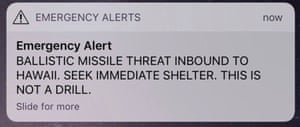- Joined
- Oct 30, 2014
- Messages
- 36,768
- Points
- 113
Shortly after 8 a.m. local time Saturday, scores of Hawaii residents received an emergency cellphone alert with an alarming message: “BALLISTIC MISSILE THREAT INBOUND TO HAWAII. SEEK IMMEDIATE SHELTER. THIS IS NOT A DRILL.”
The message, reportedly sent by the Hawaii Emergency Management Agency in error, would turn out to be a false alarm, officials said. Nevertheless, it would take 38 minutes for authorities to clear up the mistake with a follow-up alert.
The time in between sparked a brief panic in a state where fears of an attack by North Korea have been heightened in recent months. Residents and tourists reported seeking shelter, frantically gathering supplies, and calling and texting loved ones to say their goodbyes. Afterward, there was widespread anger at the false alarm, as Hawaii officials vowed to get to the bottom of how an error of such magnitude had been made.

According to screenshots, the initial alert urging people to seek shelter was sent out around 8:07 a.m. local time. Courtney McLaughlin, a wedding coordinator on Kauai island, said the alerts quickly turned a serene Saturday morning into “mass hysteria” on the roads.
“My boyfriend was like, ‘Who do we sue for this?’ We don’t just need an apology, we need an explanation. Someone could have had a heart attack,” McLaughlin, 29, said. “It took something that’s kind of incomprehensible and very quickly made it very personal. All of a sudden going through your mind is, ‘Is this the end of my life?’ I called my mom, I called my dad, I called my brother and basically said my goodbyes.”
Honolulu resident Noah Tom was picking up breakfast for a meeting when he heard of the alerts. Thinking he might only have 15 to 20 minutes before a missile strike, Tom considered how his family was split up among three locations: He had just dropped off his oldest daughter at the airport, while his two younger children were at home. His wife was already at work.
“I literally sent out ‘I love you’ texts to as many family members as I could. It was all kind of surreal at that point,” Tom, 48, told The Washington Post. He made the difficult decision of turning the car toward home, where his two youngest children were. “I figured it was the largest grouping of my family.”
At 8:20 a.m. local time, the Hawaii Emergency Management Agency tweeted there was ‘NO missile threat’ to the state. But it wouldn’t be until 8:45 a.m. local time that an additional cellphone alert was sent to Hawaii residents advising them that the first warning had been a false alarm.
https://www.washingtonpost.com/news...ssile-threat-messages/?utm_term=.530963333ae8
The message, reportedly sent by the Hawaii Emergency Management Agency in error, would turn out to be a false alarm, officials said. Nevertheless, it would take 38 minutes for authorities to clear up the mistake with a follow-up alert.
The time in between sparked a brief panic in a state where fears of an attack by North Korea have been heightened in recent months. Residents and tourists reported seeking shelter, frantically gathering supplies, and calling and texting loved ones to say their goodbyes. Afterward, there was widespread anger at the false alarm, as Hawaii officials vowed to get to the bottom of how an error of such magnitude had been made.

According to screenshots, the initial alert urging people to seek shelter was sent out around 8:07 a.m. local time. Courtney McLaughlin, a wedding coordinator on Kauai island, said the alerts quickly turned a serene Saturday morning into “mass hysteria” on the roads.
“My boyfriend was like, ‘Who do we sue for this?’ We don’t just need an apology, we need an explanation. Someone could have had a heart attack,” McLaughlin, 29, said. “It took something that’s kind of incomprehensible and very quickly made it very personal. All of a sudden going through your mind is, ‘Is this the end of my life?’ I called my mom, I called my dad, I called my brother and basically said my goodbyes.”
Honolulu resident Noah Tom was picking up breakfast for a meeting when he heard of the alerts. Thinking he might only have 15 to 20 minutes before a missile strike, Tom considered how his family was split up among three locations: He had just dropped off his oldest daughter at the airport, while his two younger children were at home. His wife was already at work.
“I literally sent out ‘I love you’ texts to as many family members as I could. It was all kind of surreal at that point,” Tom, 48, told The Washington Post. He made the difficult decision of turning the car toward home, where his two youngest children were. “I figured it was the largest grouping of my family.”
At 8:20 a.m. local time, the Hawaii Emergency Management Agency tweeted there was ‘NO missile threat’ to the state. But it wouldn’t be until 8:45 a.m. local time that an additional cellphone alert was sent to Hawaii residents advising them that the first warning had been a false alarm.
https://www.washingtonpost.com/news...ssile-threat-messages/?utm_term=.530963333ae8


